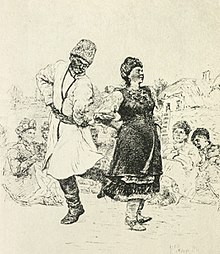കൊസാചോക്ക്
പതിനാറാം നൂറ്റാണ്ടിൽ[1] കോസാക്കുകളിൽ നിന്ന് ഉത്ഭവിച്ച ഒരു പരമ്പരാഗത ഉക്രേനിയൻ നാടോടി നൃത്തമാണ് കൊസാചോക്ക് (ഉക്രേനിയൻ: кoзачо́к; ബെലാറഷ്യൻ: казачо́к; റഷ്യൻ: казачо́к).[2][3][4][5] 17, 18 നൂറ്റാണ്ടുകളിൽ ഇത് സമകാലീന ഉക്രെയ്നിലും യൂറോപ്പിലെ കുലീന ദർബാറുകളിലും അവതരിപ്പിക്കപ്പെട്ടു.[6] സ്ത്രീ നയിക്കുകയും പുരുഷൻ പിന്തുടരുകയും അവരുടെ രൂപങ്ങൾ അനുകരിക്കുകയും ചെയ്യുന്നു. കൈകൊട്ടിക്കൊണ്ട് ചലന വ്യതിയാനങ്ങളെ സ്ത്രീ സൂചിപ്പിക്കുന്നു. പതിനേഴാം നൂറ്റാണ്ടിൽ യൂറോപ്പിലെ ദർബാർ സംഗീതത്തിൽ കൊസാചോക്ക് ഫാഷനായി മാറി.[1]
 | |
| Genre | ഫോക് ഡാൻസ് |
|---|---|
| Time signature | 2/4 |
"കൊസാചോക്ക്" എന്ന പദം 16 മുതൽ 19 വരെ നൂറ്റാണ്ടിലെ ഉക്രേനിയൻ സഞ്ചാരികളുടെ പാവ തിയേറ്ററായ വെർട്ടെപ്പിൽ കണ്ടെത്താൻ കഴിയും. ആദ്യത്തേത് ക്രിസ്തുവിന്റെ ജനനത്തെ നാടകീയമാക്കുന്ന രണ്ട് ഭാഗങ്ങൾ ഉൾക്കൊള്ളുന്ന വെർട്ടെപ്പ് നാടകങ്ങളിൽ രണ്ടാമത്തേത് മതേതര ഇതിവൃത്തം, പലപ്പോഴും ധാർമ്മിക കഥയായിരുന്നു. റഷ്യയിൽ കുബാൻ കസാചോക്ക്(തെക്കൻ റഷ്യയിലെ ക്രാസ്നോഡാർ മേഖല), ടെർ കസാചോക്ക് (വടക്കൻ കോക്കസസ് മേഖല) എന്നീ കൊസാചോക്ക് നൃത്തത്തിന്റെ വ്യത്യസ്ത പതിപ്പുകൾ നിലവിലുണ്ട്.[7]ചരിത്രപരമായി ഈ പ്രദേശങ്ങളിൽ പ്രധാനമായും ഉക്രേനിയൻ ജനസംഖ്യയുണ്ടായിരുന്നുവെങ്കിലും സോവിയറ്റ് കാലഘട്ടത്തിൽ നാടകീയമായും മനഃപൂർവ്വമായും കുറഞ്ഞു.[8]
ഉക്രെയ്നിൽ ഇത് പലപ്പോഴും സപ്പോരിഷ്യൻ പ്രദേശത്തു നിന്നുള്ള കോസാക്കുകളെ കേന്ദ്രീകരിച്ചുള്ള ഒരു സന്തോഷകരമായ ആഘോഷമായിരുന്നു. അവർ പാടുകയും ബന്ദുറ വായിക്കുകയും നൃത്തം ചെയ്യുകയും ചെയ്തു. ഈ നൃത്തം "വെർട്ടെപ്നി കൊസാചോക്ക്" എന്നറിയപ്പെട്ടു. അക്ഷരാർത്ഥത്തിൽ "വെർട്ടെപ്പിൽ നിന്നുള്ള ഒരു കോസാക്ക്" എന്നാണ് അർത്ഥമാക്കുന്നത്. ഒപ്പം ഉജ്ജ്വലമായ കൊസാക് സ്വഭാവത്തിന്റെ എല്ലാ സവിശേഷതകളും പ്രദർശിപ്പിക്കുകയും ചെയ്തു. കിഴക്കൻ സ്ലാവിക് നൃത്തങ്ങളിൽ റഷ്യയുടെ പടിഞ്ഞാറൻ-മധ്യ പ്രദേശങ്ങളായ ബെൽഗൊറോഡ് ഒബ്ലാസ്റ്റ് ഒരു പ്രധാന പങ്ക് വഹിച്ചു. റഷ്യയിൽ, ചരിത്രപരമായി ഒരു വലിയ ഉക്രേനിയൻ ജനസംഖ്യയുള്ള [9]ബെൽഗൊറോഡിലെ കൊസാചോക്ക് പ്രദേശം പോലുള്ള നിരവധി സാംസ്കാരിക നിധികൾ അവയുടെ വേരുകളിലൂടെ കണ്ടെത്താൻ കഴിയും. [10]
ഉക്രേനിയൻ നൃത്തത്തിന്റെ ക്രമീകരണത്തിനും ലോകമെമ്പാടുമുള്ള പ്രവർത്തനങ്ങൾക്കും പേരുകേട്ട ഉക്രേനിയൻ നൃത്തസംവിധായകനും നർത്തകനുമായ വാസിൽ അവ്രാമെങ്കോ, ഒന്നു മുതൽ നാല് വരെയുള്ള ദമ്പതികളുടെ പോഡിലിയ പ്രദേശത്തെ തദ്ദേശിയായ "കൊസാചോക്ക് പോഡിൽസി" എന്ന കോസാക്ക് കോർട്ട്ഷിപ്പ് നൃത്തത്തിന് പ്രശസ്തനായിരുന്നു. 1917-1921 കാലഘട്ടത്തിൽ ഉക്രേനിയൻ നാടകകൃത്തും എഴുത്തുകാരനുമായ മാർക്കോ ക്രോപിവ്നിറ്റ്സ്കിയുടെ നാടകങ്ങൾ ഉൾപ്പെടെ നാടക തലമുറകളിൽ അവതരിപ്പിച്ച നൃത്തങ്ങളുടെ ശേഖരത്തിലെ ഉറവിടങ്ങളിൽ നിന്ന് നടത്തിയ നാടകവേലയിൽ നിന്നാണ് അദ്ദേഹം "കൊസാചോക്ക് പോഡിൽസ്കി" പഠിച്ചത്.[11]
പതിനേഴാം നൂറ്റാണ്ടിലെ പോളിഷ് കുലീനനും സംഗീതസംവിധായകനുമായ കാസിമിയേഴ്സ് സ്റ്റാനിസ്വാ റുഡോമിന-ദുസിയാക്കി ആണ് കൊസാചോക്കിന്റെ ആദ്യ സംഗീത ക്രമീകരണം നടത്തിയതായി അറിയപ്പെടുന്നത്.[12][13]പതിനെട്ടാം നൂറ്റാണ്ടിന്റെ രണ്ടാം പകുതി മുതൽ കൊസാചോക്ക് മെലഡികളുടെ കൈയെഴുത്തുപ്രതി ശേഖരങ്ങളുണ്ട്. അച്ചടിച്ച ശേഖരങ്ങൾ ആ നൂറ്റാണ്ടിന്റെ അവസാനത്തോടെ പ്രത്യക്ഷപ്പെടാൻ തുടങ്ങിയിരുന്നു. ബെർലിൻ സ്റ്റേറ്റ് ലൈബ്രറിയിൽ "ദുസിയാക്കി-ബുച്ച്" എന്ന പേരിൽ ദുസിയാക്കിയുടെ സ്കോർ സംരക്ഷിക്കപ്പെട്ടു.
പതിനെട്ടാം നൂറ്റാണ്ടിൽ പോളിഷ് സംഗീതത്തിൽ കൊസാചോക്ക് മെലഡികൾ ഉപയോഗിച്ചു.[1][14][15]
അവലംബം
തിരുത്തുക- ↑ 1.0 1.1 1.2 "Kozachok". Encyclopedia of Ukraine. 1989.
- ↑ Nahachewsky, Andriy (2011-11-16). Ukrainian Dance: A Cross-Cultural Approach (in ഇംഗ്ലീഷ്). McFarland. p. 102. ISBN 978-0-7864-8706-6.
- ↑ Major, Alice; Gordey, Gordon (1991). Ukrainian Shumka Dancers: tradition in motion (in ഇംഗ്ലീഷ്). Reidmore Books. ISBN 9781895073010.
- ↑ Feldman, Walter Zev (2016-10-03). Klezmer: Music, History, and Memory (in ഇംഗ്ലീഷ്). Oxford University Press. p. 208, 388. ISBN 978-0-19-024452-1.
- ↑ "Traditional Ukrainian Dance". RusMoose.com (in അമേരിക്കൻ ഇംഗ്ലീഷ്). 2016-02-10. Retrieved 2019-11-30.
- ↑ "Kozachok". www.encyclopediaofukraine.com. Retrieved 2019-11-30.
- ↑ "Traditional Ukrainian Dance | Folk Dance from Ukraine". RusMoose.com (in അമേരിക്കൻ ഇംഗ്ലീഷ്). 2016-02-10. Retrieved 2019-11-30.
- ↑ "Kuban".
According to the 1897 census, 49.1 percent of the population considered their native language to be Ukrainian, and 41.8 percent considered it to be Russian (not including Black Sea gubernia). Over one-third of the inhabitants were born outside Kuban. Of these, 24.2 percent were born in the ethnically mixed Voronezh and Kursk gubernias and 40.1 percent were born in the Ukrainian Kharkiv gubernia, Poltava gubernia, Katerynoslav gubernia, and Chernihiv gubernia; the number of immigrants from Kyiv gubernia and Kherson gubernia was also significant. By 1926, the total population of Kuban was 3,557,000 (including Black Sea gubernia). Of these, 47.1 percent (1,674,000) were Ukrainians, 41 percent (1,460,000) Russians, 4.9 percent (172,000) various Caucasian mountain peoples, 2.2 percent (79,000)
- ↑ "Belgorod Oblast". Encyclopedia of Ukraine.
According to the Soviet census of 1979, Russians constituted 94 percent of the population, and Ukrainians accounted for 4.8 percent. These statistics were doctored, however, for the purpose of demonstrating that the political border between Ukraine and Russia coincides with the ethnic border. According to the generally reliable census of 1926, the territory of present-day Belgorod oblast was then inhabited by 642,000 Ukrainians (40.2 percent) and 948,000 Russians (59.4 percent) out of a total population of 1,596,000. Ukrainians were in the majority in 7 out of the 18 raions, Russians in 6, and the numbers were about equal in 5. The southwest and the southeast parts of Belgorod oblast are in Ukrainian ethnic territory. In the past these two parts belonged to the Slobidska Ukraine regiments, while the central part of the oblast, including Belgorod, was colonized mostly by Russians. The Ukrainian part of Belgorod oblast covers 14,500 sq km and in 1926 had a population of 770,000, of which 460,000 (59.7 percent) was Ukrainian and 307,000 (39.9 percent) was Russian. In 1926, 182,000 Ukrainians lived in the rest of the oblast. According to the Russian census of 2010 (which followed the trend set by the earlier Soviet census), Russians constitute 94.4 percent of the population, and Ukrainians account for 2.8 percent.
- ↑ "Kozachok Destination Guide (Belgorod, Russia) – Trip-Suggest". trip-suggest.com. Retrieved 2019-03-08.
- ↑ Nahachewsky, Andriy (2011-11-16). Ukrainian Dance: A Cross-Cultural Approach (in ഇംഗ്ലീഷ്). McFarland. ISBN 978-0-7864-8706-6.
- ↑ Soroker, Yakov (1995). Ukrainian Musical Elements in Classical Music. Canadian Institute of Ukrainian Studies Press. p. 64. ISBN 1-895571-06-5.
- ↑ Deasy, Aidan (2010). The Seventeenth-Century Battaglie for Lute in Italy. Edith Cowan University: Western Australian Academy of Performing Arts. p. 19.
- ↑ Findeizen, N.; Velimirovic, M.; Jensen, C.; Brown, M.; Waugh, D. C. (2008). History of Music in Russia from Antiquity to 1800. Indiana University Press. p. 388. ISBN 978-0-253-02352-0.
- ↑ Mischakoff, A.; Heiles, A. M. (1983). Khandoshkin and the beginning of Russian string music. Russian music studies. UMI Research Press. p. 21. ISBN 978-0-8357-1428-0.
ഉറവിടങ്ങൾ
തിരുത്തുക- Bobri, Vladimir – Notes on the Ukrainian Folk Dances //Guitar review - #33, Summer, 1970 p. 27
- Ukrayins'ke kozatstvo – (Entsyklopedia) Kiev, 2006